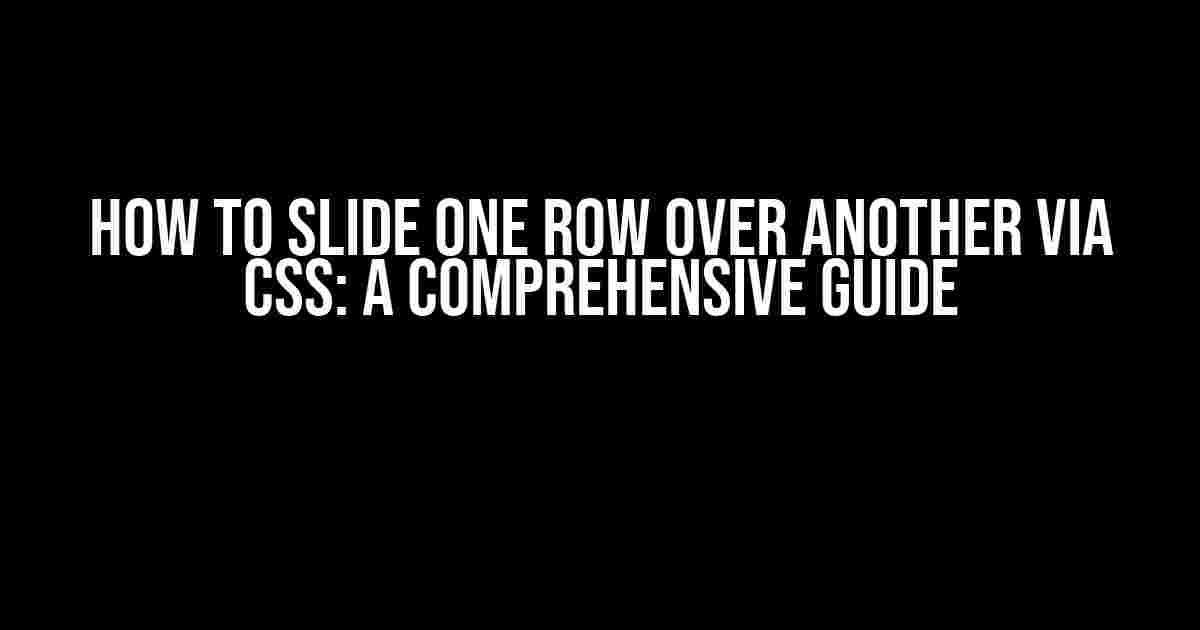Are you tired of boring, static layouts that fail to capture the attention of your audience? Do you want to add some visual flair to your website or application? Look no further! In this article, we’ll show you how to create a mesmerizing sliding effect where one row slides over another using CSS. This technique is perfect for creating engaging UI components, such as accordions, navigation menus, and more.
What You’ll Need
To follow along with this tutorial, you’ll need a basic understanding of HTML and CSS. If you’re new to CSS, don’t worry! We’ll break down each step into simple, easy-to-follow instructions. You’ll also need a code editor or IDE of your choice.
HTML Structure
Let’s start with the basic HTML structure for our sliding row effect. We’ll create a container element that will hold our two rows:
<div class="container">
<div class="row top-row">
<p>Top Row Content</p>
</div>
<div class="row bottom-row">
<p>Bottom Row Content</p>
</div>
</div>
CSS Setup
Next, we’ll add some basic CSS to style our rows and container:
.container {
position: relative;
width: 100%;
height: 200px;
overflow: hidden;
}
.row {
position: absolute;
top: 0;
left: 0;
width: 100%;
height: 100%;
background-color: #f7f7f7;
padding: 20px;
border: 1px solid #ccc;
}
.top-row {
z-index: 1;
}
.bottom-row {
z-index: 2;
}
The Magic Happens
Now that we have our basic structure and styles in place, it’s time to add the sliding effect. We’ll use CSS transitions and animations to create a smooth, sliding motion.
Adding the Slide Effect
Let’s add a CSS transition to our `.row` class to enable smooth animation:
.row {
...
transition: transform 0.5s ease-in-out;
}
Next, we’ll add a CSS animation to our `.bottom-row` class to create the sliding effect:
.bottom-row {
...
animation: slide 2s forwards;
}
@keyframes slide {
0% {
transform: translateY(-100%);
}
100% {
transform: translateY(0);
}
}
In this example, we’re using the `animation` property to define a animation called `slide`, which will run for 2 seconds and move the `.bottom-row` element from `translateY(-100%)` to `translateY(0)`. This will create a smooth sliding effect, where the bottom row slides up and covers the top row.
Customizing the Effect
Now that we have the basic sliding effect working, let’s explore some ways to customize it to fit your needs.
Changing the Animation Timing
To change the animation timing, simply adjust the `animation-duration` property:
.bottom-row {
...
animation-duration: 1s; /* Change to 1 second */
}
Reversing the Animation
To reverse the animation, simply swap the `translateY` values in the `@keyframes` rule:
.bottom-row {
...
animation: slide 2s forwards;
}
@keyframes slide {
0% {
transform: translateY(0);
}
100% {
transform: translateY(-100%);
}
}
This will create a sliding effect where the bottom row slides down and reveals the top row.
Common Issues and Solutions
As with any CSS technique, you may encounter some common issues when implementing the sliding row effect. Here are some solutions to common problems:
| Issue | Solution |
|---|---|
| Rows not sliding smoothly | Check that you have added the `transition` property to the `.row` class. Also, ensure that the animation duration is set correctly. |
| Rows overlapping | Check that the `z-index` property is set correctly for each row. Make sure the bottom row has a higher `z-index` than the top row. |
| Animation not running | Check that the animation is defined correctly in the CSS. Also, ensure that the animation is being triggered correctly (e.g., on hover or click). |
Conclusion
And that’s it! With these simple steps, you’ve successfully created a sliding row effect using CSS. This technique is perfect for adding visual flair to your website or application, and can be customized to fit your specific needs. Remember to experiment with different animation timing, directions, and effects to create unique and engaging UI components.
So, what are you waiting for? Get creative and start sliding those rows!
Frequently Asked Question
Get ready to master the art of sliding rows like a pro! Learn how to slide one row over another via CSS with these frequently asked questions.
What is the basic concept behind sliding one row over another in CSS?
The basic concept is to use relative positioning on the parent element and absolute positioning on the child elements. This allows you to position the rows on top of each other, creating the sliding effect!
How do I set up the HTML structure for sliding rows?
You’ll need a container element (like a `div`) to wrap around your rows. Then, create two separate elements (like `div`s or `ul`s) to represent your rows. Give them distinctive classes or IDs to target them with CSS.
What CSS properties do I need to use to create the sliding effect?
You’ll need to use `position: relative` on the container element and `position: absolute` on the child elements (the rows). Then, use `top` and `left` properties to position the rows on top of each other. Finally, add some CSS transitions to create the sliding effect!
How do I add animations to the sliding effect?
Add CSS transitions to the child elements to create a smooth sliding effect. Use `transition: top 0.5s ease-in-out` or `transition: transform 0.5s ease-in-out` to animate the rows. You can also use CSS keyframe animations for more complex effects!
What are some common challenges when implementing sliding rows in CSS?
Some common challenges include managing the z-index, dealing with overflow issues, and ensuring the sliding effect works across different browsers and devices. Be prepared to troubleshoot and adjust your CSS accordingly!
